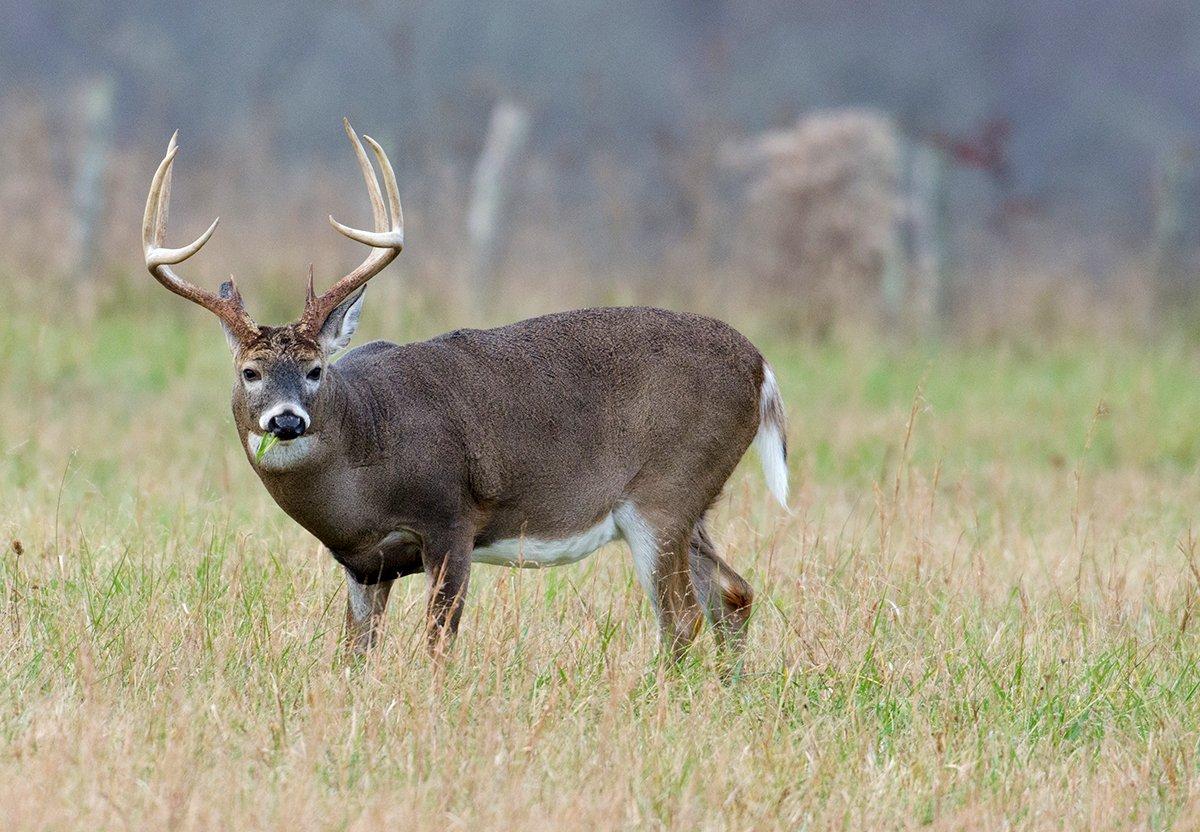Monsters are lurking the woods, and the last day of October is a fine one for punching your tag with something scary big
Halloween is a time for candies and costumes. But to deer hunters, it's much more than that. Hunting on Halloween has long been a tradition, and it's the signature kickoff for the rut. The sun sets on October, and the madness begins. Still, it requires the right approach to be successful. Here's everything you need to know about hunting on and around this day, from why it's so good to the tactical approaches you should try. This is your complete playbook for arrowing a big Halloween buck.
Halloween Has a History of Excellence
Each year, hundreds of typical and non-typical whitetails are entered into the Boone and Crockett books, and thousands of Pope and Young deer are, too. Interestingly, a high number of these deer fall on October 31, or around it. This tells me the time frame is a great window to capitalize on big, mature bucks. While it isn't quite as good as when bucks really start chasing a week or so later, it holds value for a reason.
That reason is predictable whitetail behavior. Deer operate on a similar calendar each year, without much of the variation that some might suggest. Photoperiod (daylight length) drives the rut north of the 35th latitude, and that remains constant each fall. Keith Beasley, cohost of Canada in the Rough TV, says the best five days are around Halloween, October 28 to November 2.
The days surrounding Halloween seem to be magical and a favorite time to be perched in a tree, Beasley said. Bucks young and old are finally stepping outside of their core summer areas. These areas hold them through mid- to late-October, are extremely small, and have all they need with food, water, and shelter. It holds them tight and makes them very difficult to hunt as travel is limited.
Which brings us to October 31 — Halloween. You shouldn't expect any tending but seeking is likely. And if you see a buck really chasing a doe, and not just bumping her, expect madness, because every buck in the area will be after her. She's likely the first to enter estrus.
If you see a buck really chasing a doe, and not just bumping her, expect madness, because every buck in the area will be after her.
Even without early estrus does, bucks' testosterone levels are rising rapidly. Think jumpy thoroughbreds in the starting gate. They're frustrated. It's almost time to run, but not quite. Thus, they have a lot of pent-up energy, which sparks increased daylight movement. Deer are encountering each other more as this movement increases. That maximizes confrontations and can lead to plenty of sparring, and even all-out fights.
In late October, the pre-rut feelings and emotions kick in, Beasley said. They start making rubs and scrapes in their small areas, and start to walk outside of that, searching for groups of does. The best part is, does are not ready for them and the tending phase is still a week or two away. Therefore, these bucks start to compete, spar, and show dominance.
In summary, don't expect a lot of true rut behavior, especially among the oldest bucks in the herd. Instead, bank on a continuation (and amplification) of pre-rut patterns that bucks have followed since mid-October. Only now, deer are moving more and farther during legal shooting hours. After all, it's the beginning of the seeking phase.
(Don't Miss: Here's Where Pressured Bucks Spend the Most Time)
Hunt the Best Conditions
As with any time of deer season, the hunting improves under the right conditions. This is true on Halloween, too. The ideal situation is a cold front with a wave of high pressure on its heels.
In addition, a consistent northerly wind (or whatever works for your preferred stand location), would be nice, too. Pair that with temperatures five to 10 degrees below the annual average, and maybe even a short misting rain to jumpstart the afternoon parade, and things get good in a hurry.
Of course, the opposite conditions can flip the script just as quickly. Scorching heat, heavy rain, and unfavorable winds can shut the action down faster than an interstate traffic jam. There isn't much you can do about these things except cut the distance deer must travel to reach you in daylight.
(Buy Alert: EZ Bow Sling)
Hunt the Best Spot
Under normal to great weather conditions, deer are likely to travel farther during daylight. With poor conditions, they might cover shorter distances. Regardless of conditions, it's best to analyze trail camera photos and recent in-the-field sightings and sign. Consider the conditions, wind directions, and other factors before selecting a location. Then, select a low, medium, or high-impact approach. And always listen to your gut. That's experience and instinct whispering in both ears.
A low-impact option offers minimal risk. You're hunting farther from bedding areas with lower odds of spooking deer, but also of seeing them. This might be the edge of a major destination food source, just inside of cover along the edge of agricultural fields, inside field corners, and other locations well away from buck beds.
Second, a medium-impact option includes moderate risk. The likelihood of seeing and spooking deer gradually increases. You're hunting farther from major food sources and closer to bedding areas. These spots might be thick, overgrown staging areas, rub or scrape lines, secluded water holes, small food sources between bedding and major food sources, and more.
The high-impact option involves the highest risk. You'll likely see, shoot, or spook the deer you're after. With this option, you're hunting the edge of known buck bedding or in some cases, just inside of it. This isn't easy to do, though, and isn't advised under most circumstances.
All things considered, choosing a hunting spot isn't easy, and it boils down to risk vs. reward. If you think the odds of getting a shot opportunity are high, it's worth the risk. If not, it isn't. Analyze the situation and decide accordingly.
(Don't Miss: 5 Best Stand Setups for Pre-Rut Bowhunting)
Pick Your Approach
Once you've chosen a location, it's time to decide on tactics. Most hunters choose to remain silent and stay off the radar. Others are more into luring bucks into range. Where legal, scents are popular. Whether it be in a scrape, mock scrape, or drag line, people use these frequently.
Other hunters like to blind call, commonly using grunting, bleating, and other vocalizations to draw deer within range. Rattling pairs nicely with calling, but don't overdo it. Start light and increase in intensity if nothing responds.
A few tricks help during this time of year, Beasley said. Don't be intimidated by rattling and grunting. Do it. Rattle and grunt as you see fit. Then lay them aside, and watch.
A great way to add realism to calling is to use a decoy. Bucks sometimes need a visual to commit to the sounds you make, and decoys can enrage them enough to bring those testosterone-driven jocks to charge in. Of course, the more balanced the deer herd is the better these tactics work. For example, a herd with a 1:1 buck-to-doe ratio is more likely to produce such action than one that's 1:3 or 1:4.
This is a great hunting time, centering our focus on food sources and travel routes, we get in the tree and sit, Beasley said. We also pull out all the aggressive tactics and use all sorts of deer calls: doe bleats, buck grunts, tending grunts etc. We use rattling horns to fake a fight. The combination of all these tactics seems to play with all the bucks' emotions.
Other tactics are possible selections, too, such as still hunting, spot-and-stalk hunting, and deer drives. They can all work, but they're risky tactics that leave behind a pressured wake of disrupted deer. It's generally a one-and-done type situation.
(Buy Alert: 23" EZ Hanger + Arrow Puller Combination 2 Pack)
Bringing It Home
With proper scouting and preparation, the odds of filling a tag on Halloween are good. Still, work diligently to apply as little pressure as possible. This starts by selecting a good stand location.
Next, it's good to establish good entry routes. These should take you to your hunting spot without bumping deer. It can be the best treestand location, but if you can't get there without spooking deer (especially target bucks), it's useless. These should also minimize the amount of ground scent deer pick up later. To reduce exposure, sneak through shallow creeks, drainage ditches, and other low-lying or water-based areas where scent is less of a factor.
Even with proper preparation, you may not tag that deer on the first outing. Because of this, it's imperative to use quality exit routes. These allow you to get back to the truck without spooking deer after the hunt. Because if you do pressure deer, it reduces the odds of success the next time. Hunting is a marathon, not a sprint.
Deer season is here, and Halloween is sneaking up on us. Don't spook that big buck you've been after, though. Send an arrow through it instead.
(Don't Miss: 15 Places Big Bucks Bed That Deer Hunters Should Hunt)









